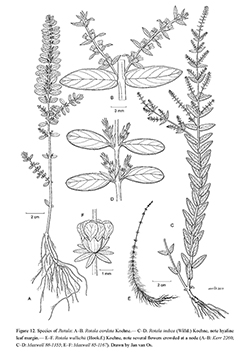e-Flora of Thailand
Volume 11 > Part 4 > Year 2014 > Page 587 > Lythraceae > Rotala
1. Rotala cordata Koehnewfo-0001280517
Bot. Jahrb. Syst. 1(2): 172. 1880; Pflanzenr. IV. 216 (Heft 17): 40. 1903; C.D.K.Cook, Boissiera 29: 93, f. 20: A–E, map 12. 1979; P.H.Hô, Ill. Fl. Vietnam 2(1): 32, f. 3683. 1992; H.N.Qin & S.A.Graham, Fl. China 13: 285. 2007; H.N.Qin, S.A.Graham & M.G.Gilbert, Fl. China Ill. 13: f. 302: 5–7. 2008. Fig. 12: A–B.
Accepted Name : This is currently accepted.
Synonyms & Citations :
Description : Herbs, amphibious or terrestrial, annual. Stems erect, branched or simple, to 50 cm tall, with 4 distinct white wings running into the leaf or bract margins. Leaves decussate, sessile; lamina lanceolate to ovate or oblong, to 25 mm long, cordate at base, subobtuse at apex. Bracts on main stem like foliage leaves, bracts on lateral inflorescences lanceolate or oblong, spreading or recurved, cordate at base, 2–3 times as long as subtended flower; bracteoles 2, minute, ca 0.2 mm long. Flowers subsessile, usually borne on contracted lateral branches or occasionally on the main stem; calyx tube campanulate, becoming subglobose in fruit, 1–1.5 mm long; calyx lobes 4, triangular, 0.5 mm long, acuminate, usually minutely toothed at margin; calyx appendages absent; petals pink or purple, obovate, equalling or to twice as long as calyx lobes, persistent in fruit; stamens 4, inserted at about one-third up the calyx tube; anthers as long as or or slightly exceeding the tips of the calyx teeth; ovary globose; style 1–1.5 mm long, persistent; stigma exserted. Capsules globose, 1–1.5 mm diam., included within the calyx tube, opening by 3 valves. Seeds subovoid, ca 0.5 mm long.
Thailand : NORTHERN: Chiang Mai (Bo Luang, Doi Suthep – type of Rotala diversifolia: Hosseus 275, isotypes -K L; Mae Klang Falls, Omkoi); NORTH-EASTERN: Sakon Nakhon (Phu Phan NP); SOUTH-WESTERN: Kanchanaburi (Huai Ban Kao).
Distribution : NE India (type), through SE Asia to New Guinea.
Ecology : In moist places: near ponds, in clearings and deep forests, by streams and waterfalls; also on limestone; 350–1,200 m alt. Flowering and fruiting: November–January.

